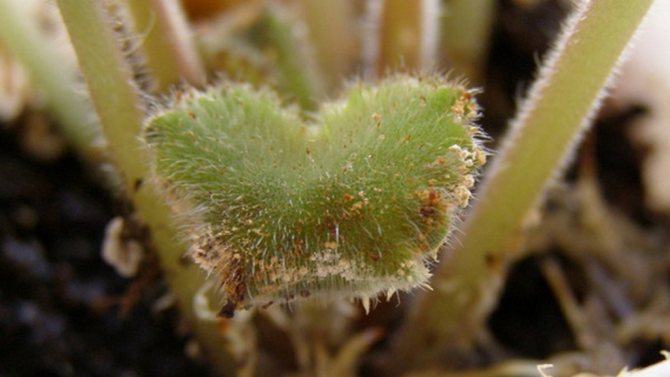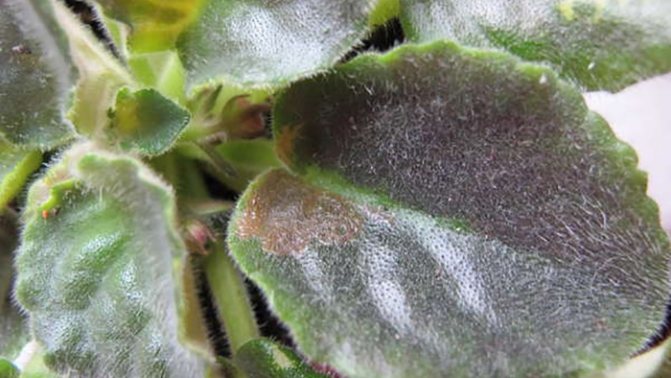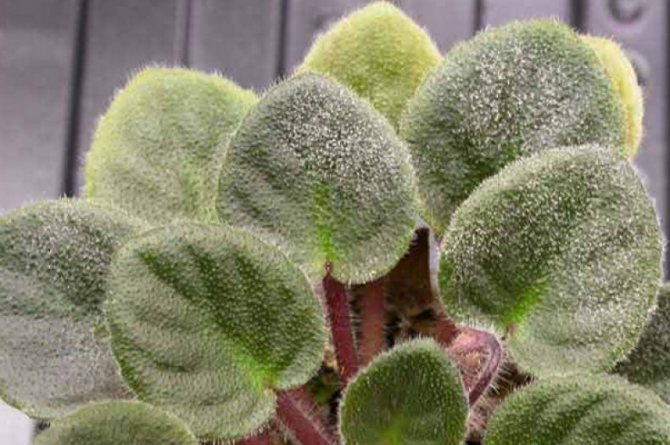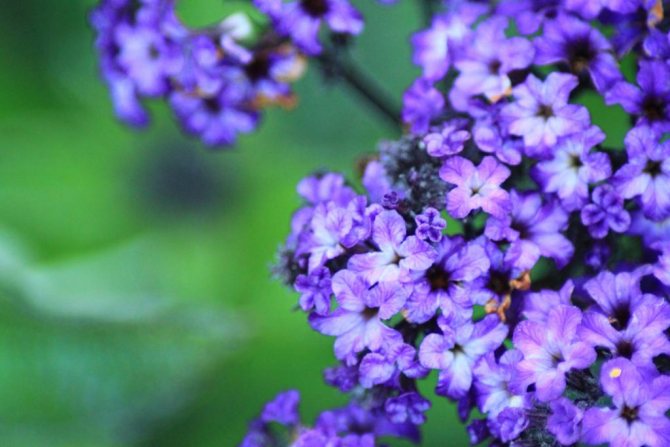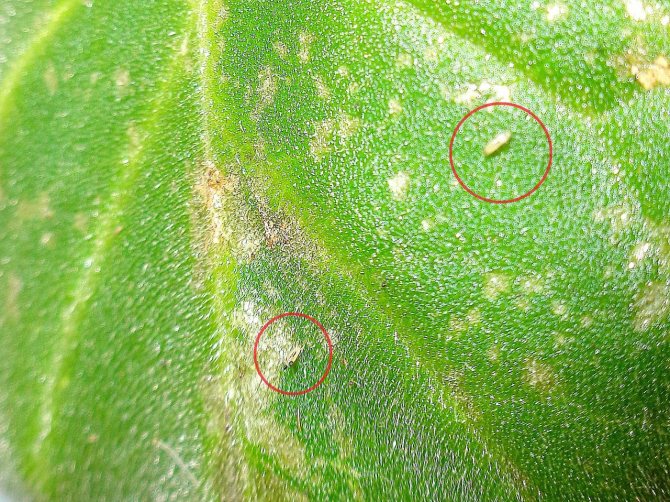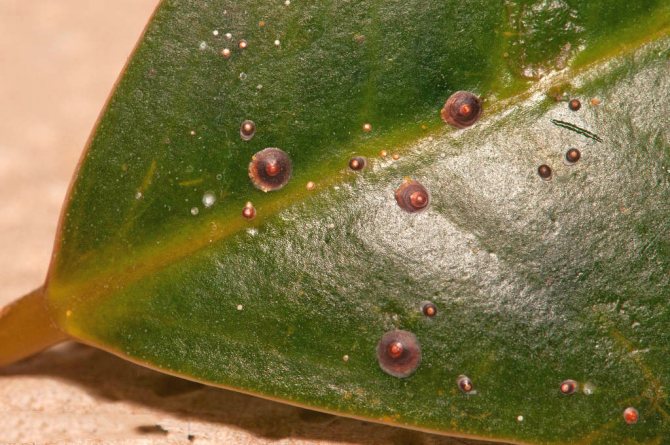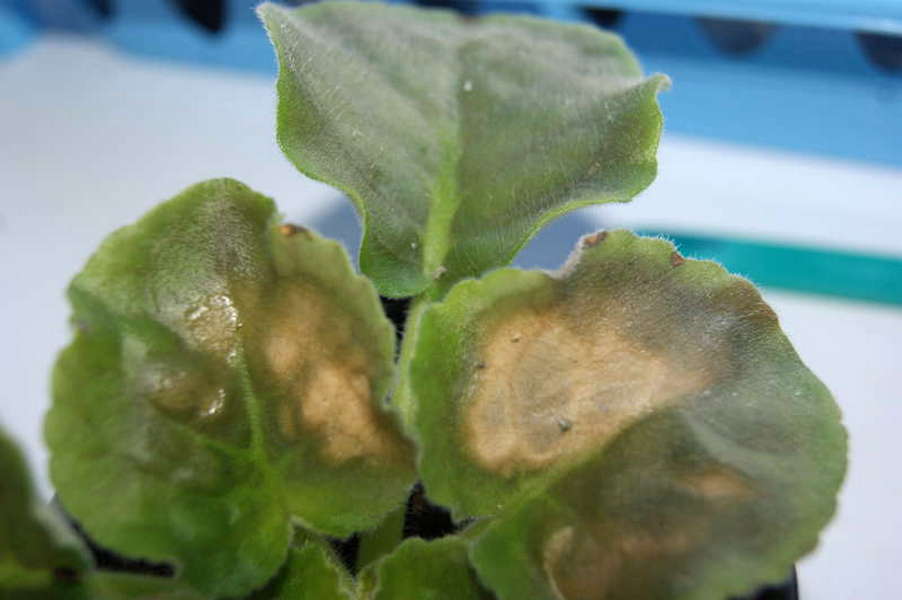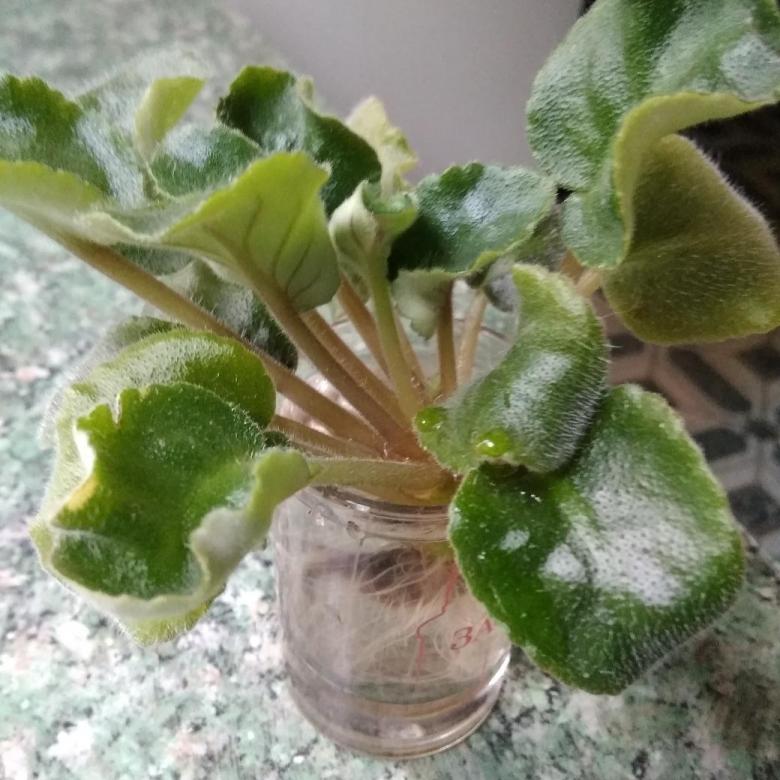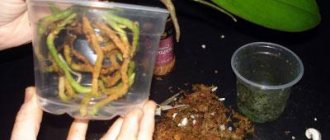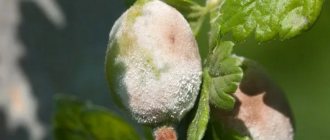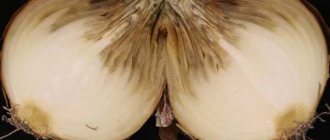Violets (Saintpaulias), like many indoor plants, are susceptible to various diseases and pests. It is fair to say that with all the necessary preventive measures and appropriate care, the risk of injury is minimized. And yet you should know what are the most common diseases and pests of violets and what methods and ways to combat them.

Violet disease - leaf and root rot and their treatment
The symptoms of this violet disease can be considered:
- loss of leaf turgor;
- loss of the natural color of the rosette;
- wilting of petioles and leaf plates.
Fresh articles about garden and vegetable garden
How to feed thuja in summer?
How to feed violets to bloom at home
How to feed violets?
With the comprehensive nature of the violet disease, as in the photograph, treatment can only be urgent and cardinal. The damaged tissue is removed, the saintpaulia is rooted with a healthy leaf that can give new rosettes.
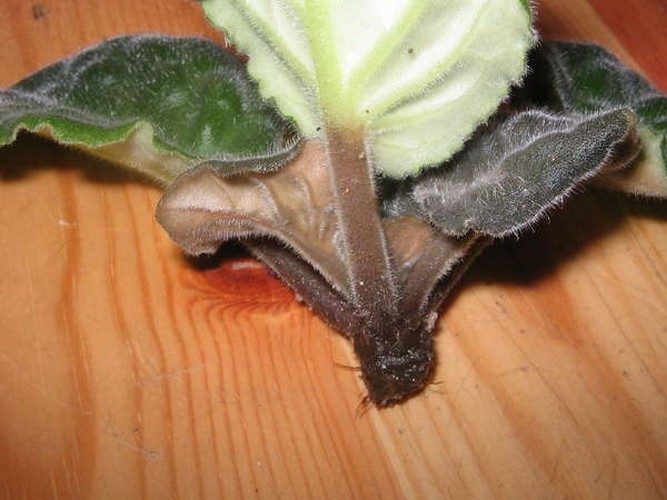

Brown rot very young rosettes, babies and rooted leaves are affected. In the latter case, the stem at the base becomes brownish-brown, softens and becomes thinner. Whitish mycelium threads are found on the soil under the outlet. And if you do not take urgent measures, the violet disease spreads to neighboring plants.
As a preventive measure, rooted plants are treated with a contact fungicide, do not deepen, and then the area under the stem is irrigated with phytosporin or a chemical similar in effect.
Gray rot also leads to liquefaction and weakening of the green parts of the plant, while a gray fluffy bloom is clearly visible on the affected surface. All leaves with signs of violet disease, as well as dead leaf blades and cuttings are removed, preventing them from falling to the ground. To reduce the risk of infection during the cool season, it is imperative:
- avoid excessive air humidity;
- refuse to spray outlets;
- water the violets correctly, avoiding stagnant moisture and condensation.
Of the chemicals for the treatment of outlets and their protection, fast and foundation are chosen.
Violet pests
It is necessary to inspect the leaves, buds, petioles of violets regularly. Especially in spring and summer, when the windows are open for ventilation. Be aware of insect pests when buying a new potted plant from a flower shop and decorating your home with cut flowers. It doesn't matter if they are cut in your garden or in an industrial greenhouse. With flowers, with soil for transplanting by air, there is a chance that pests will get on your blooming violets. The most common pests of aphids:
- Ticks (flat calf, cyclamen, spiderweb).
- Shield (false shield).
- Nematodes.
- Thrips.
- Aphid.
- Mealybug.
There are many pests parasitizing on the violet. A photo of insects and violets damaged by them will help to identify the parasite in time and choose the right way to fight.
Mites
Ticks feed on violet juice. The size of ticks is so small that it is difficult to see them with the naked eye.
Spider mite


Spider mite
The most common type of mite that settles on the petioles and leaves of indoor violets is the spider mite. We saw the thinnest white cobweb on the petioles, buds, leaves - this was a spider mite on the violet. A poor plant loses its decorative effect from the loss of juice.Deformed brown leaves appear on the bushes. They dry and fall off.
Cyclamen mite
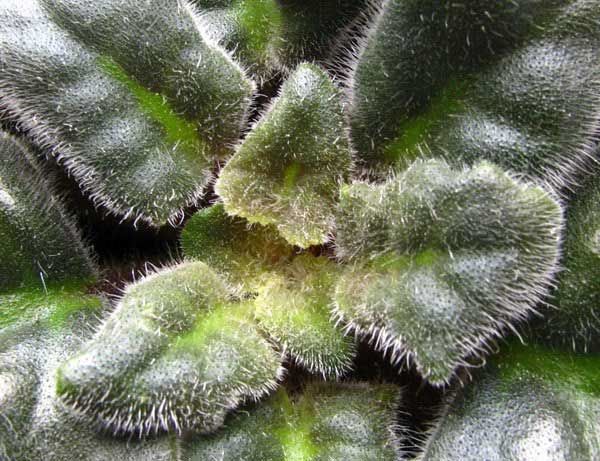

Cyclamen mite
If the violet does not grow, it stops blooming, the young leaves are covered with yellow spots and are compacted - a cyclamen tick has settled on the flower. It is populated at the top of the outlet.
Platypus mite


Platypus mite
Florists are less likely to meet this mite on their violets. Signs of the presence of a flatling mite on a violet are leaves twisted inward. The leaves gradually wither, dry and fall off. The violet may die.
Folk recipes for ticks on violets
We saw the first signs of a tick on a violet, do not pull, use a simple folk trick for a start. You can take vodka or alcohol. Use a cotton swab moistened with alcohol to wipe the stems and violet leaves.
After a few days, sprinkle the violet with onion peel infusion. Pour 80 g of onion husks into a 3-liter jar, pour boiling water over it. After a couple of days, the infusion can be filtered and used for spraying. Treat all flower plants in the room for prevention.
Chemistry for ticks


Folk recipes are effective at the initial stage. When the concentration of insects is threshold, the flower is threatened with death, the only way out is chemistry. Use acaricides - special preparations for fighting ticks:
- Apollo - an enteric drug. Apollo destroys tick eggs, kills larvae, inhibits the sexual activity of adults.
- Neoron - a new agent that acts on adult ticks from the inside. The duration of exposure is 10-40 days.
- Fitoverm – effective insectoacaricide of intestinal action. Valid up to 20 days from the date of processing.
Treatment of violets from ticks: video
Shield


Shield
It is difficult to get rid of the scabbard and false shield on the violet. One female scale insect, caught on a flower, lays many eggs in a few days. The larvae (vagabonds), when they are born, feed on the juice of the violet. The underside of the leaves of the infected violet is covered with red-brown scutes. Yellow spots are visible on the upper surface of the leaf plate. Adults secrete a sticky mass in which a sooty fungus multiplies. Sometimes it is easier to destroy a violet.
Adults are not afraid of insecticides, so they must be removed mechanically. To do this, you need a cotton swab moistened with the drug: "Aktellik", "Aktar", "Karbofos". You can treat the leaves with soapy water, dropping kerosene into it, it is even easier to take 1 liter of water, pour 2 tbsp into it. l olive oil. With the resulting oily solution, treat all the leaves and petioles of the violets.
Thrips
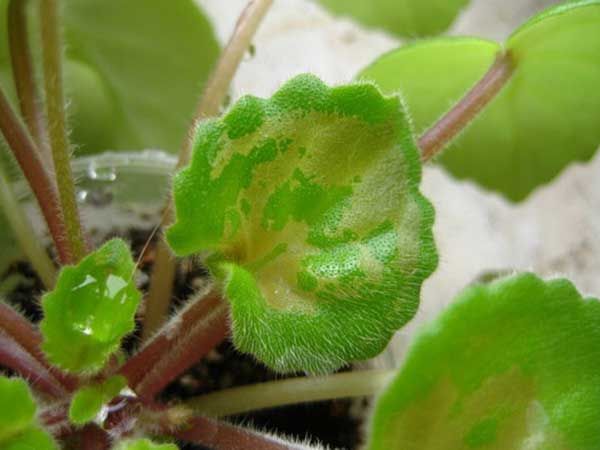

Thrips
The first sign of thrips on violets is pollen scattering, the second is yellow paths on the leaves. A recipe for an experienced violet lover will help get rid of thrips on violets. Take any flea shampoo (25 ml) and 1 ampoule "Fitoverm-M". Dilute them in 5-6 liters of water.
Wrap the violet (pot) in a plastic bag so that the earth does not fall out. Wash violet leaves in warm running water. Dip the socket in a bowl of soapy water for 10 seconds. After the procedure, pour the soil in the pot with a solution of 2 preparations: Fitoverm-M, Aktara, prepared according to the instructions.
Nematodes
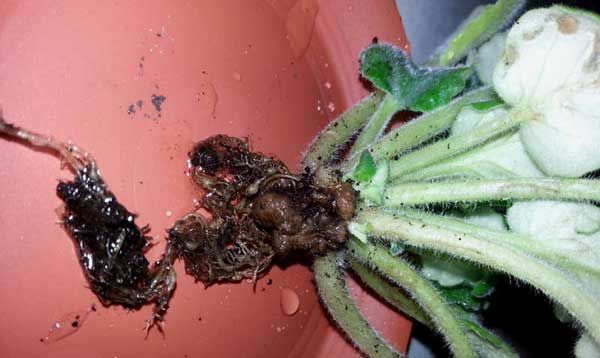

Nematodes
Nematodes - filamentous, transparent worms (up to 2 mm). They live in the soil, infect the root system. Signs of violets affected by nematodes:
- elongated, thickened stem;
- shortened petioles, petioles are completely absent from the upper leaves;
- leaves become unnaturally dark green, become dense;
- the edges of the leaves fold inward;
- flowers are small, ugly;
- on the roots of thickening (galls);
- roots are brown, black.
It is impossible to get rid of nematodes, prevention saves.When planting, crushed dry marigold petals and peat can be added to the soil. Nematodes do not like peat. Pour violets with marigold infusion or water infused with peat. Nematodes do not like vermicompost. Substrate based on vermicompost (Terra-Vita) is ideal for violets. Use new transplant pots, treat old ones with a strong disinfectant.
Mealybug
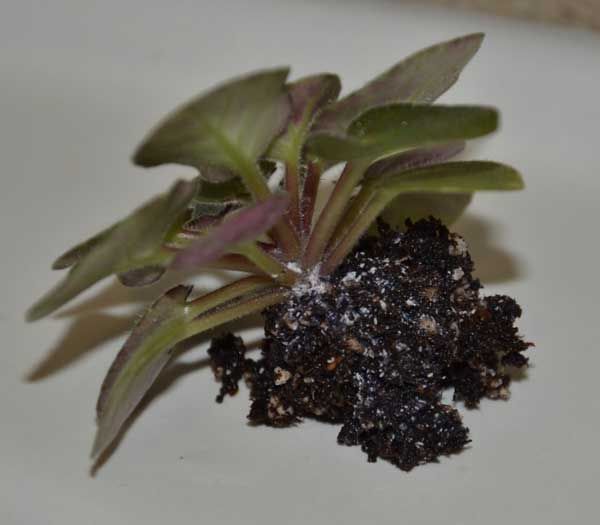

Mealybug
Mealybugs can be seen with the naked eye, the size of the insect depends on the variety (3-6 mm). Violets are harmed by adults and their larvae. Habitat:
- buds;
- young leaves;
- young shoots.
Infected violet stunted. On damaged surfaces, you can see a white coating that looks like cotton wool. In the later stages, the fungus multiplies on the sweet secretions of insects.
You can get rid of the worm on violets. Moisten a brush in soapy water, clean all parts of the plant from insects and plaque. Prepare a green soap solution. Grate 10 g per liter of water and stir. Sprinkle violet. It needs to be processed 3 times with an interval of 7 days.
Aphid


Aphid
Aphids on violets are visible to the naked eye, forms their colonies on the inner surface of the leaves, in the buds. Adults and larvae suck the sap, oppressing the plant. A fungus grows on the sticky secretions of aphids. Aphids are a carrier of viruses. Signs of aphid-infested violets:
- the crown of the flower is deformed;
- flowers of an ugly shape;
- buds do not develop;
- leaves are twisted.
It is not difficult to fight aphids, especially at the very beginning. When small green or black insects appear (the color depends on the type of aphid), wash the violet with soapy water. Tear off loose leaves. After a few days, repeat the treatment. In advanced cases, use chemistry:
- Actellik;
- Fitoverm;
- Intavir.
Powdery mildew on Saintpaulias and treatment
This is a disease of violet leaves, pathogens are powdery mildew fungi - parasites. These fungi multiply by spores and grow quickly in favorable conditions, therefore, with this disease, small white dots first appear on the leaves, which increase in size and can envelop the entire surface of the leaf, as if with a white cobweb. White bloom can appear on the outside and inside of the leaves, and flower buds can also be affected.
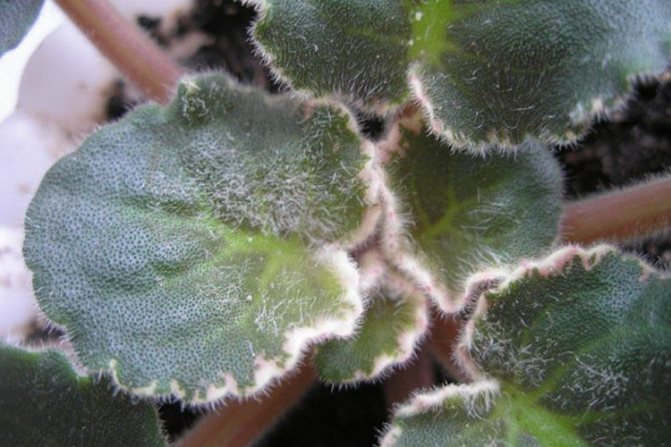

A favorable environment for the development of fungi is low temperature and high humidity. Young and only transplanted plants are most susceptible to infection with powdery mildew. Infection with powdery mildew can occur: when watering, from an infected plant to a healthy one, fungal spores can be carried by insects or air currents.
Treatment of a flower from powdery mildew can be done both with ordinary sulfur and using antifungal drugs for violets. And also there are many traditional medicines to combat powdery mildew - this is the treatment of plants with various solutions. These solutions can be prepared by yourself: from soda ash with soap, whey, kefir, dry mustard, potassium permanganate, ash, mullein, horsetail infusion, garlic, onion husks. To avoid the development of powdery mildew, it is necessary not to create favorable conditions for the fungi.
Violation of proper watering, as a result - spots on violet leaves
Watering is a very important process when growing violets. It provides a number of rules to be followed when growing violets:
- when watering with water at a low temperature, the plant instantly reacts negatively, specks of light tones appear on the leaves. When a direct sunlight hits a plant, or rather wet leaves, a leaf plate is burned, and brown spots are formed.
- watering is necessary only with water at room temperature.The process itself is carried out as recommended, in the evening. At such a moment, your plant will not be able to get burned if it is located on the windowsill on the sunny side.
Fukariosis violet disease and treatment
Signs: browning of the petioles and falling of violet leaves.
Causes: This is a disease caused by a fungus of the genus Fusarium. From the soil, the fungus enters the roots of the plant and affects the vessels of all its parts - the stem, peduncles, leaf cuttings. These fungi release toxic substances that cause browning and rotting. It appears, like late blight, with excessive watering and cold. Its appearance is promoted by sharp temperature changes, irrigation with cold water, heavy particle size distribution of the soil, which is why water stagnates in it.
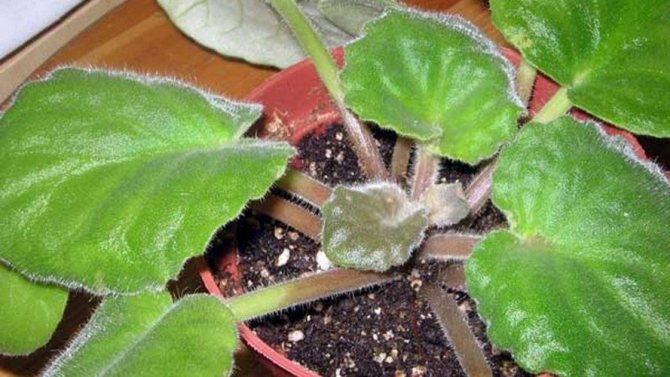

Treatment: apply the same treatment as for late blight. In addition to phytosporin, for preventive purposes, you can water with fund azole. To do this, dilute 1 gram of foundation ash in 1 liter of water. Watering is carried out once every two months.
Treatment methods
After improper care
The reason for rusty spots is different, so after learning why this happened, the violet must be treated. A set of activities is carried out depending on the cause of wilting:
- In the case of alkalization of the soil, the plant is transplanted. The root is shaken off the ground and washed with a solution of potassium permanganate, then the violet is planted in new soil;
- Watering is carried out with warm water under the root of the flower, trying not to get on the leaves;
- If the plant has been overdried for a long time, watering is resumed in small portions once every few days.
Timely assistance will allow the plant recover quickly.
Fungal diseases and infections
Brown edges of the leaves indicate that the violet is sick. A source of microbial infection may be:
- Another diseased plant;
- Soil infected with a pathogenic microbe;
- Infected instrument used when transplanting a flower.
First of all, the plant is exposed to the disease, weakened by improper care.
Treatment of diseased violets carried out comprehensively:
- Apply chemical means of protection;
- Normalize care;
- Rejuvenate the flower.
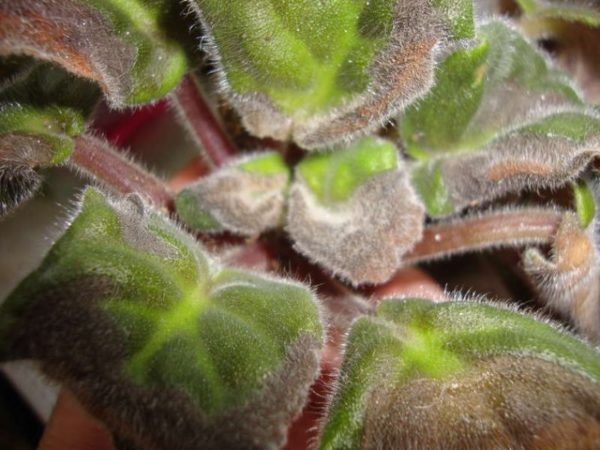

Fungal diseases in violets cannot always be cured.
Sometimes, in order to save a collection, you have to resort to drastic measures - destruction of damaged plants... You can see how the brown spots appeared in the photo above.
To prevent the spread of an infection infected the violet is isolated and disinfected:
- Diseased leaves are removed and destroyed;
- In the case of a fungal infection, the plant is sprayed with a solution of the fungicide Fundazol, Bordeaux liquid, Skor or others;
- With a bacterial infection, the antibiotic Fitolavin, Streptomycin will help.
Important! In the case of diagnosing root rot, in order to preserve the variety, it is worth rooting a violet leaf.
After being hit by pests
When pests are detected:
- Mechanically clean the surface of leaves and stems from insects;
- The flower is treated with an insecticide (Fitoverm, Actellik, etc.);
- After processing, a transparent bag is put on over the flower for a day.
To be sure to get rid of pests, processing violets repeat after two weeks.
Violet leaf spot and treatment
Viral diseases can slow down the development of violets, change the appearance of the plates and stop flowering.
The spread of the disease can be caused by the colonization of a flower with parasites. Bronze virus is accompanied by the appearance of mutilated leaves, stained brownish.
Viral diseases are not cured, so the plant is destroyed.
Fresh articles about garden and vegetable garden
Katarantus: growing and care, photo
Drip irrigation from bottles in the greenhouse
Cabbage: planting seedlings timing
Late blight of Saintpaulia rosettes and treatment
Brown dry spots on the leafy part of the plant become a sign of late blight. The spots spread very quickly.In the shortest possible time, the plant tissue undergoes necrosis and the rosette fades.


If the top of the outlet is not damaged, then you can cut it off, treat it with a fungicide, cut off the damaged areas and root it. Individual leaves are also suitable for rooting.
The rest of the flower is destroyed. Neighboring flowers must be processed.
Common diseases with photos
Saintpaulias can be affected by various pathogens of viral, bacterial and fungal origin, here are the most common and dangerous of them.
Powdery mildew
In the initial stage of the disease, powdery mildew on the leaves and petioles appears a small white bloom, resembling scattered flour. Spreading, the fungus damages all parts of the violet, the leaves become uneven, the plant is oppressed and dies. To prevent the appearance of powdery mildew, prevention is carried out as follows: reduce the intake of nitrogenous fertilizers, watering and air humidity, ventilate the room with violets.
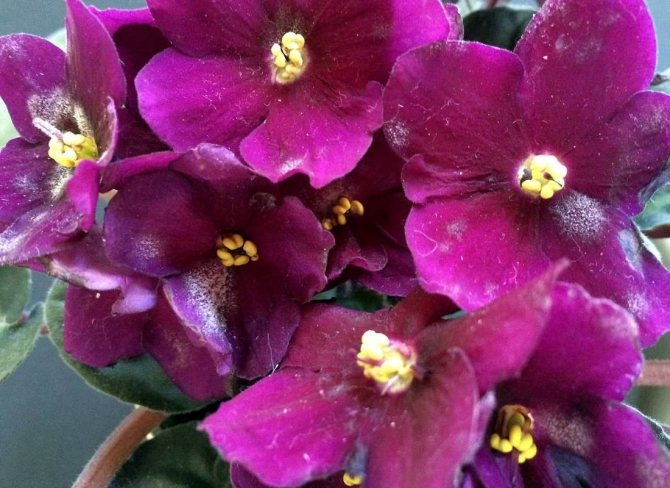

Downy mildew is caused by fungi from the Peronospore family. The symptoms of the lesion will be different:
- a silvery bloom appears on the underside of the leaf;
- then light green, brownish, red-brown spots appear on the upper surface of the leaves;
- without treatment, the plant weakens, withers and dies.
Late blight
A dangerous fungal disease that causes damage to the roots, and then the aerial parts of the violet. The first sign may be wilting of leaves with sufficient watering. When spreading, late blight causes root rot, the stems turn brown in the affected areas, the leaves also become covered with brown-brown spots. The high humidity of the soil and air promotes the reproduction of the fungus.
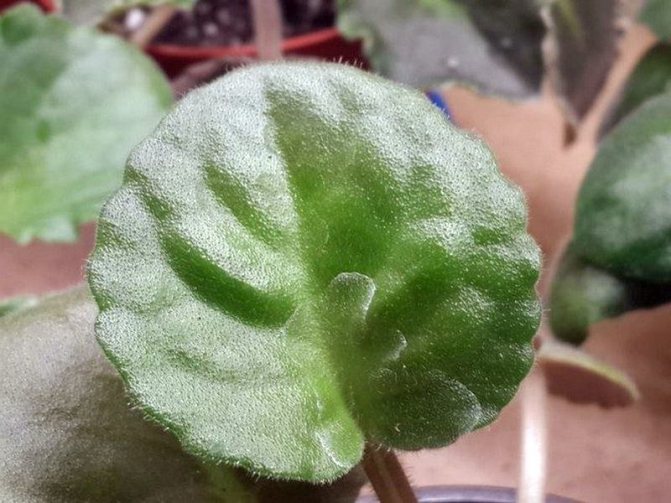

A fungal disease that is easily recognized by brownish spots on the top of the leaves. On the inner surface of the leaves, there are fungal colonies - yellow tubercles. Most often, plants get sick with rust during the transition from winter to spring, when their immunity decreases. You need to know how to fight infection - with the help of broad-spectrum fungicides.
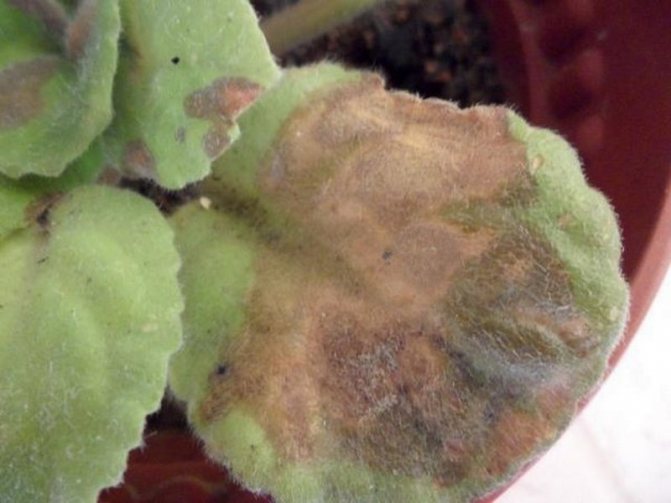

The causative agents of this disease are fungi from the Fusarium genus, which penetrate from the infected soil into the root system, and then spread through the conducting vessels of the entire plant. The fungus shuts off the food and water supply of the plant, causing its early death. The leaf stalks begin to darken and fall off, the roots when viewed are black, do not hold an earthen lump. The plant can be saved only in the initial stage of the disease.
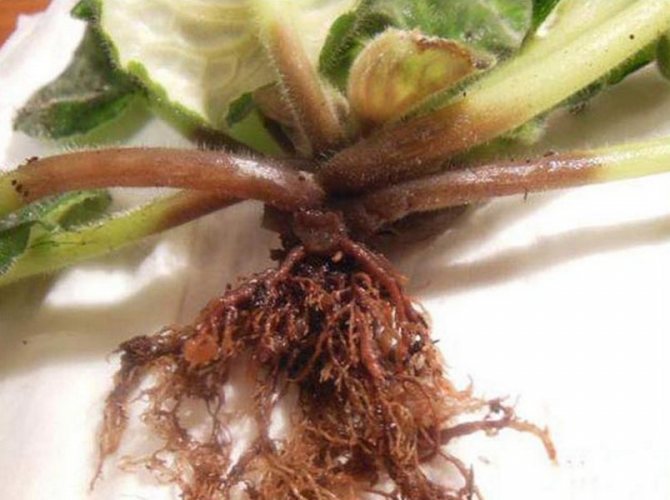

Gray rot
Gray rot, or botridiosis, is one of the main diseases of the violet, also of a fungal nature. Infested violets develop fluffy molds on the leaves and buds. It is necessary to fight the fungus with the help of fungicides, it is required to reduce the humidity of the room and watering, to arrange ventilation.
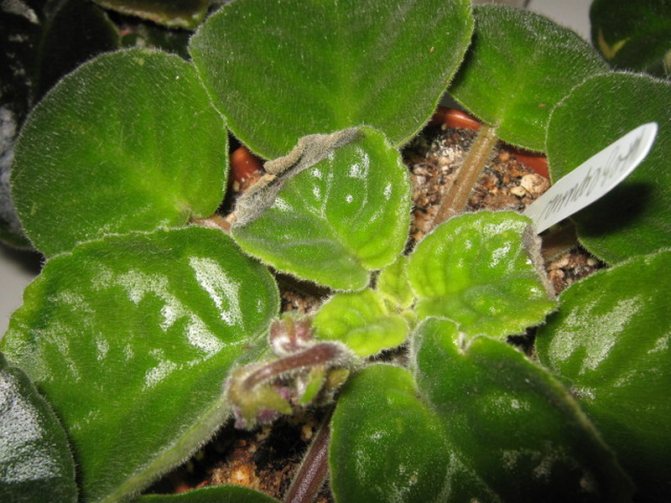

Violet Bronze and Leaf Spot Viruses and Treatment
Diseases of a viral nature change the appearance of leaf plates, tissue supply and plant development. These diseases can be the reason why violets do not bloom at home, and then stop developing altogether.
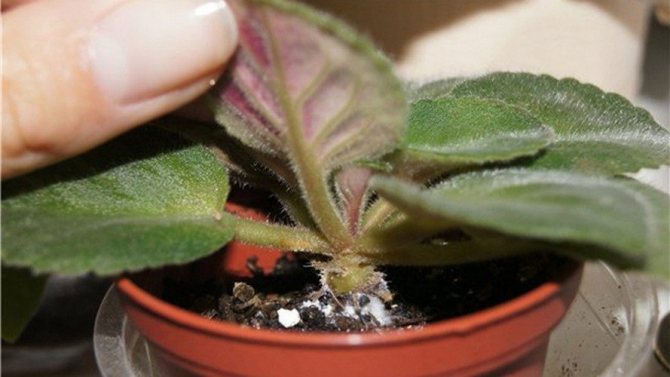

Bronze virus, for example, produces ugly discolored leaves. Such plants sometimes turn out to be unviable and are destroyed. And pests found in apartments can spread the disease of violets. In this case, these are thrips.
Fighting fungus infection: saving violets without harm to ourselves
To understand why light spots appeared on the leaves of the violet, and then led to the death of the plant, and even infected the rest of the "inhabitants" of the windowsill, you first need to understand that there are more than a hundred species of mushrooms of this kind, which strive to penetrate into our house.But if everything is already neglected and it is too late to prevent something, although it is much easier than treating the affected plants, you can try to stop the spread.
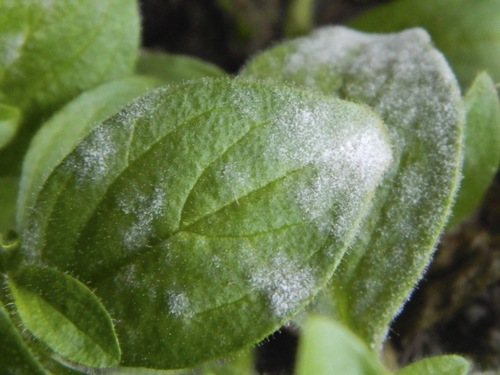

- Everything that is affected by the fungus must be mercilessly cut off and immediately destroyed.
- Hands, as well as the knife you used to clean, should be washed with antibacterial detergents.
- It is necessary to provide the plant with the most comfortable conditions, and you need to take care of morning watering, as well as the absence of drafts, from which the flowers themselves can get sick.
- If almost the entire plant is covered with spots, it is better to destroy it immediately so that it does not infect the rest, since it will hardly be possible to cure it.
Thus, mushrooms can really be called the most dangerous enemies of violets, as well as our personal ones. Experienced experts recommend not to use professional-grade chemical remedies for combating diseases of violets at home, although they are on sale. The thing is that all these drugs can turn out to be unsafe for human health if they are used without observing special precautions, which are simply impossible or almost impossible to provide at home.
A few simple rules for the selection and use of fugnicides
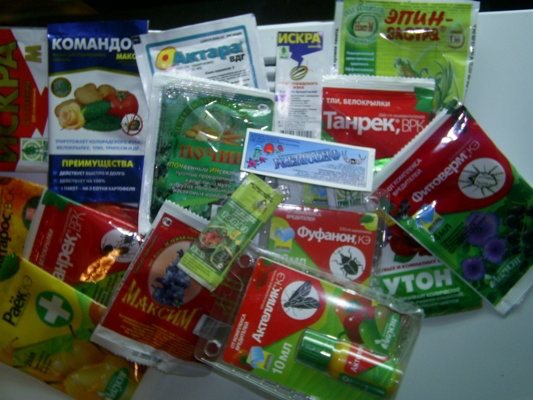

- When choosing a product, you should pay attention to the fact that it must be applicable for home use.
- The toxicity class of the drug should not exceed the third, otherwise it is simply dangerous.
- Pay attention to the purpose, because most drugs are intended only for prophylaxis, that is, for the affected plants, there will definitely not be any sense from them.
- Please note that the benefits must necessarily exceed the harm. That is, ineffective drugs can get into the soil and damage the roots, while not having any effect on the disease itself.
- It is better to choose systemic fungicides, as they simply spread throughout the plant with sap. Thus, the maximum therapeutic effect is achieved.
- Try to avoid the use of drugs that have a strong, unpleasant odor, especially if you will be doing the treatment indoors.
- There are such fungicides that can spoil the appearance of the plant, you need to know this, for example, spraying with "Maxim" will give a persistent reddish bloom, and "Bordeaux mixture" - white.
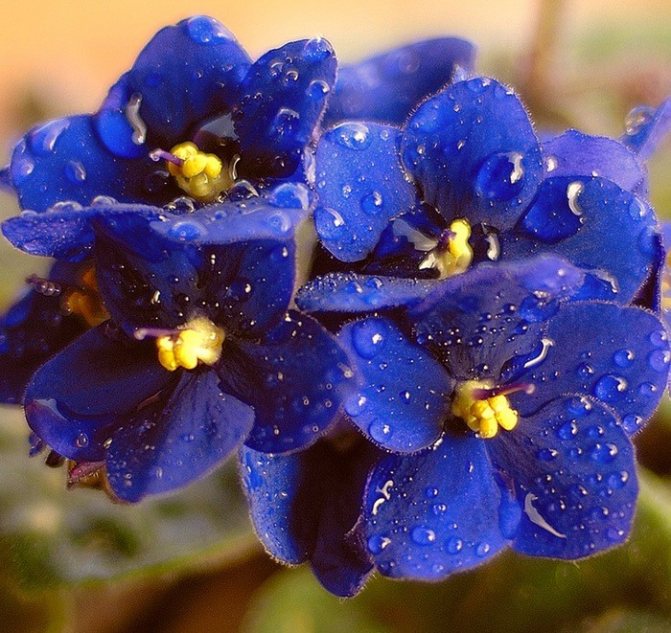

It is optimal to choose fungicides that have the qualities of biostimulants that increase the resistance of plants to diseases at times. It is these drugs that should be looked for on the shelves. For example, offhand you can name "Agate", "Sodium humate", "Zircon", "Epin" and so on. However, whatever one may say, the best remedy is to create the most comfortable conditions under which the plant will not be exposed to risks. It is in this case that you will save yourself from many unnecessary things, and your violets will always be beautiful, strong and healthy.
Gray rot on violets and its treatment
Other indoor plants, not only Saintpaulia, suffer from this fungal disease. The infection affects the tissue of young seedlings, leaves, flowers and buds. The plant turns brown, decays or becomes gray-brown. The violet becomes covered with brown spots that quickly spread throughout the plant. Usually, this type of parasite penetrates weakened plants through mechanical damage. In this case, you need to spray with a copper - soap solution (dilute 20 g of liquid potassium soap and 2 g of copper sulfate in 1 liter of water). In order not to face infection, experts recommend preventive procedures. Feed with fertilizers and microelements, which significantly increase the plant's resistance.
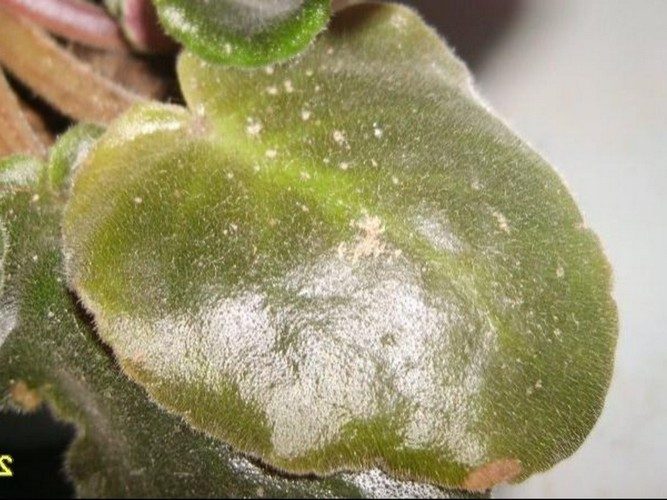

Diseases as a result of improper care
Some diseases of violets are not contagious, but they can kill a plant no worse than an infection.
Vascular bacteriosis
A multifaceted and insidious disease overtakes the violet at the height of summer and flowering.As soon as the heat passes over the 30⁰C mark, the plant begins to have problems with metabolism and moisture, and there is a "blockage of blood vessels". On the dead tissue particles, bacteria multiply intensively. Symptoms of bacteriosis are different - translucent brown spots appear on the inner side of the foliage plate, the petioles and stems turn glassy and turn into "jelly", the rosette rots and dies off quickly.
Since vascular bacteriosis appears due to heat, an effective way to combat it is to lower the air temperature and ventilation, but not a draft! The most reliable method is to install an air conditioner. If this is not possible, remove the violets from the windowsills to a more shaded place, on pallets with damp drainage. A diseased plant is recommended to be treated with a solution of trichodermin or trichopolum. It is also used for prevention.
Bacteriosis primarily affects weakened Saintpaulias, so focus on improving the immunity of flowers. And it strengthens:
- timely rejuvenation;
- spring (in May) transplant into a fresh substrate;
- treatment before stressful situations (heat is stress!) with immunomodulators, for example, Epin.
Violet care at home
Lighting violets
If you have many windows, choose a location in your home that has the most diffused soft light. Violets should be placed on the southern windowsill with caution, since they do not like direct sunlight, so on the southern windowsill you need to shade them: cover the window with curtains to the height of the flowers. If you spend a lot of time in the kitchen, you can place flowerpots with saintpaulias in the same place. Firstly, you will be comfortable from their presence, and secondly, violets like high humidity and good light in the kitchen.
If your home violets don't have enough light, they may look pale and sluggish. The leaves will stretch upward, the stalk will lengthen, which means that the harmonious shape of the rosette will be disturbed.
Watering violets
I water the violet plants 1-2 times a week (depending on the season). I use soft, settled water at room temperature. Some novice Saintpaulia lovers water them, like other flowers, directly from above into the ground. But this must be done extremely carefully. Moisture should not get either on the violet leaves, nor, even more so, on the flower growth points. Stagnation of water on cuttings or leaves leads to their decay. I prefer to water violets not into the ground, but pouring water into a pan up to 2/3 of the height of the pot. For flower growers, this is called "bottom watering". But in no case should you leave water in the pan "in reserve". Roots should breathe, not float! Therefore, 20-30 minutes after the soil is saturated with moisture, I drain the rest of the water.
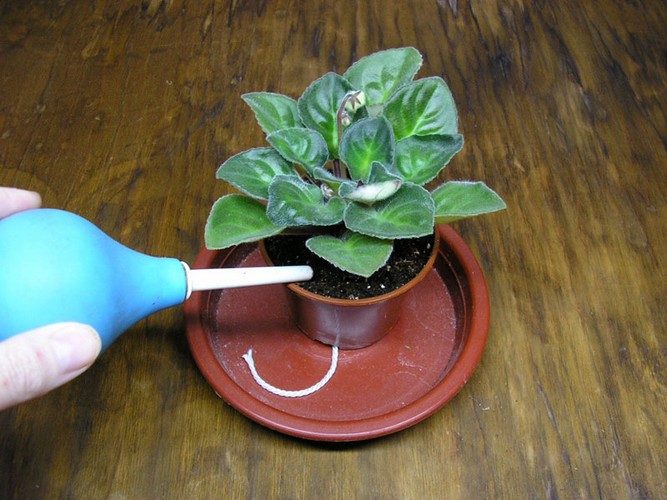

Violets should not be sprayed, but like other flowers they love moist air. Therefore, place a container of clean water next to the flowerpots, or put pieces of damp cloth or a wet sponge.
Fresh articles about garden and vegetable garden
When to Harvest Spinach?
Lantana: home care
Moles: how to deal with them?
Violet transplant
Planting a flower will not be difficult even for a novice florist. First you need to remove the plant from the pot. Then clean the roots of the old soil composition and watch them carefully. If sluggish, damaged or dry root processes and leaves are found, it is recommended to remove them immediately. But do not rush to plant the plant after that.
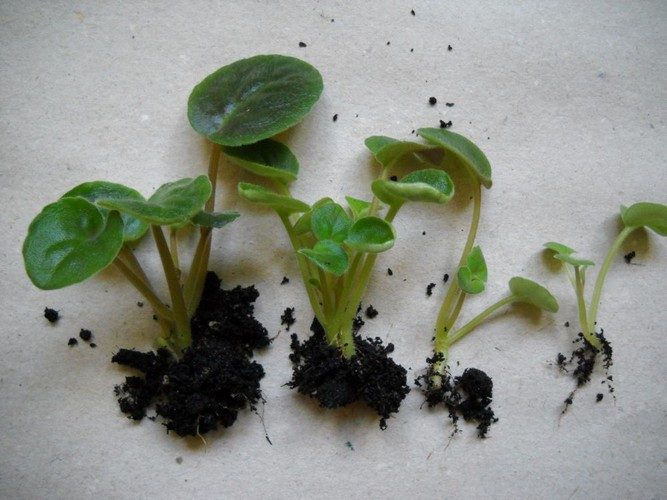

The cut sites will need to be treated with powdered activated carbon. Remember: if a significant part of the root system has been cut, it is advisable to transplant the flower into a smaller flowerpot. Now all you have to do is fill the pot with a layer of drainage, potting soil, and then place the houseplant in there.
As for the classical method of planting violets with a leaf plate, everything is quite simple here. But there is another common way - transshipment.It is often used when a flower needs to be saved from disease. That is, you will not need to completely clear the saintpaulia root system from the soil.
When planting, you only partially renew the soil composition. If the planting of an old blooming violet is carried out according to all the rules, you will soon see how much better it began to bloom. Take care of your pet, and you will be satisfied with the result. Let the violet bloom throughout the year, and caring for it will not become a burden for you.
Common problems
Why did violets become small and dull?
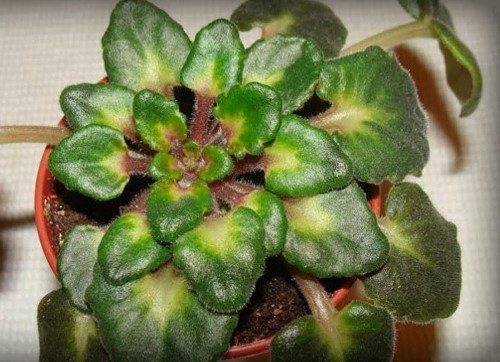

If the flower lacks natural light, then new generations of leaves, compared to old ones, grow smaller and look duller. Their petioles are elongated, the edges of the leaf plates are curved upward. It is necessary to rearrange the flower pot on a windowsill illuminated by diffused sunlight. In the autumn-winter period, additional artificial lighting up to 12-14 hours will not interfere. Just protect it from direct sunlight and drafts. You will see that the violet will soon recover and return to normal.
Why do the leaves of the violet go up?


Ideally, violet leaves are located horizontally relative to the stem. True, some varieties of violets, for example, King's Ransom, Neptune's Jewels, Happy Feet, are prone to some raising of the leaves upwards. If you have a violet of a different variety, and its leaves suddenly began to rise and curl, there may be several reasons:
- Incorrect lighting... It should be neither weak nor redundant. On the southern sunny windowsill, there must be a light shelter in the form of curtains or blinds, otherwise the sun's rays will burn the delicate leaves of the violet and, in order to protect from the sun, it raises the leaves up. The western and eastern directions are the most preferable, and on the northern windows the violets will not have enough light. The cuttings will elongate, the leaves will stretch towards the light and stretch upward. The rosette becomes like a large spider with disproportionately tall and thin peduncles.
Move the violet pot to a suitable place, well lit by the diffused rays of the sun. In case of short daylight hours, arrange additional lighting up to 12 hours a day. Then the new cuttings will be of normal size, the leaves will spread out on the sides, as they should, and the rosette will gradually become beautiful and compact again. Just remember to remove the old leaves.
- Leaf rosette too thick... Many leaves suffer from a lack of light, reach for it and stretch out. The violet should be thinned and the extra leaves removed.
- Lack of humidity in the room... If the air in your room is too dry, the violet leaves will rise up and begin to curl. Try to increase the humidity of the surrounding air by all means.
- Heat from heaters... The leaves of the violets rise when the pot stands on the windowsill, directly under which there is a battery, from which powerful streams of heat emanate upward. Violet tries to protect itself from the heat and lifts up the leaves. It will be worse if the leaves begin to turn yellow and yellow-brown spots appear on them. It should be remembered that violets like a stable air temperature (18 - 26 degrees). Close the batteries, ventilate the room, but avoid drafts.
If you analyze possible mistakes and correct them, your violets will return to normal.
Why do violet leaves curl inward?


If the even leaves of your violet suddenly began to curl inward, look for the reasons in the following list:
- You may have gotten too carried away artificial lighting... An excess of light leads to the fact that in the center of the rosette the leaves begin to grow on top of each other, their shape is deformed. The reverse side of the leaves takes on a burgundy hue. The leaf plates become stiff, brittle and curl up into a tube.Peduncles are formed so short that they cannot get out from under the leaves, they also twist and, when touched, break off. If you do not reduce the duration and intensity of the violet lighting, you will get discolored leaves of the rosette, which will soon die.
- Excessive watering... The roots of the violet, being constantly in the water, suffer from oxygen starvation, begin to rot, the plant's entire metabolism is disturbed. Leaves are curling. Violet urgently needs to be saved. Take it out of the pot. Examine the roots. Remove all rotten and damaged ones. Treat with fungicides or crushed activated carbon. Transplant the treated plant into new soil (for Saintpaulias). The pot must be clean and disinfected. Check for drainage and drainage holes in the pot.
- Excess nitrogen fertilizers in the soil... The fragile violet is not able to assimilate the excess amount of nitrogen, so it twists the leaves. If you do not take action, do not transplant the flower into a soil that is suitable for its composition - the violet may die.
- The cause of leaf curling is sometimes a terrible and dangerous enemy of indoor plants - cyclamen mite... This parasite is so tiny that it is simply impossible to detect it without special equipment. The tick affects the underside of the leaves, which curl inward. The sheet itself is, as it were, covered with a layer of dust that cannot be washed off in any way. Over time, the cyclamen tick affects the entire plant, roots begin to rot, stems dry, leaves curl. It is necessary to remove all affected parts of the plant, then treat the flower with chemical agents (Agravertin, Neoron), and several times to consolidate the success and return the violet to a normal appearance and healthy state.
It may be interesting: Anthurium (Male happiness) - care and transplant at home
Why do violet leaves wither?


If the beautiful violets suddenly began to wither the leaves, and the whole rosette is about to wither, you should hurry up and find out the reason for this disgrace. And there may be several of them:
- Banal violation of the content of the flower... Low or too high temperature, weak or too intense lighting, excess moisture, stagnant water in the pan, hard or cold water, burns of the root system due to exceeding the dose of top dressing, and others.
- Insect pests, which settled on the underside of the leaves and suck the juices out of them. Special drugs can help - acaricides. (See another article on pest control).
- Fungal diseases... The fungus can appear in the soil or get into the tissue of the violet through wounds in the stem or leaves, which appear mechanically during pruning, reproduction or transplanting of the violet. Below we describe the diseases of violets, which lead to the fact that its leaves wither and disappear.
Why do violet leaves turn yellow?
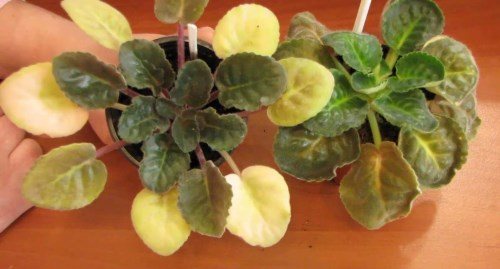

Perhaps you water it inaccurately - the water gets on the velvet violet leaves and spoils them. Yellow spots also appear from sunburn if the violet is in the sun. Ring spots can be from cold drafts during the winter season.
Why do violets have black leaves around the edges?


If the edges of the leaves began to turn black on the violet, it is necessary to find the cause of this phenomenon and eliminate it. Let's figure it out in order:
- The main reason for blackening of the leaves along the edges is excessive wetting of the substrate... Stop temporarily watering the plant, let the soil dry out. Feel the damaged areas - if they are soft, the root system may have begun to rot. Then we recommend removing the affected leaves, peduncles and stepchildren. Remove the violet bush from the pot, examine the roots. Remove the brown ones. Treat the sections with crushed activated carbon. Transplant the violet into a new substrate according to all the rules, water and spray with phytosporin, and do not allow irrigation irregularities in the future.
- Delicate violet leaves do not tolerate drafts... Drafts can cause light or brown spots on the leaves at any time of the year. But a few seconds in the cold air when ventilating the room in winter is enough for the green velvet leaves of the flower to begin to darken around the edges. Gradually, spots from the edges spread to the entire surface of the leaves. Violet in this case does not require treatment. Simply remove the damaged leaves so they don't ruin the flower's appearance.
- Lack of nutrients in the soil leads to the appearance of brown spots on the leaves of the violet. In the process of growth and flowering, the violet actively selects all nutrients from the soil. They should be regularly renewed by feeding the plant twice a month with special liquid fertilizers for violets (Saintpaulia). Also, do not neglect the annual transplantation of the plant into fresh substrate. If the flower is not transplanted for a long time, harmful salts accumulate in the soil, which interfere with the absorption of nutrients. Top dressing in this case will not be effective.
- The appearance of white bloom or spots of white or gray color on the leaves of Saintpaulia may mean any disease - fungal, bacterial or viral. We will talk about diseases of this nature later.
Why do flowers and buds of violets wither?


If the buds do not fully open, and the violet flowers dry out prematurely, you can sin for the following reasons:
- The room is too dry. It is necessary to increase the humidity of the air - the flower suffocates.
- The room is too hot. In the summer, the sun fries through the window pane, in the winter, the batteries are fried under the windowsill. There is no time for flowering.
- Not enough natural light. In winter, due to the short daylight hours, artificial lighting is required.
- Soil not suitable for violets, too acidic, with a pH below 4.5
- Excess nitrogen in the soil.
- Drafts. When ventilating, carry the violet away from the cold air currents.
Why doesn't the violet bloom?
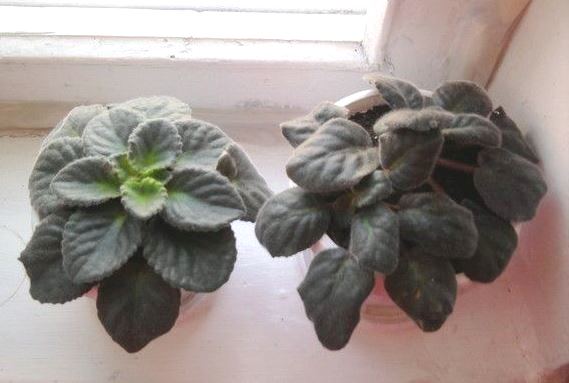

If the violet refuses to bloom, it is worth analyzing all the possible reasons for this. Again, we will have to list all the conditions under which the violet will bloom for sure:
- First, different varieties of indoor violets bloom differently. There are violets that bloom all year round. But there are varieties that bloom for a very short time, but for this they also need comfortable year-round conditions of detention and long rest. If the violet is more than three years old, then, most likely, it will bloom rarely and reluctantly. Abundant flowering is usually observed on young rosettes, the age of which does not exceed three years. So, propagate your favorite varieties on time. You can tackle this winter by planting daughter rosettes or rooting leafy cuttings. By spring they will grow up, adapt and, quite possibly, bloom.
- It is necessary to use a suitable pot for the violets. Young bushes grow well in 5x5 cm pots, medium rosettes need 7x7 cm pots, and adult specimens can easily fit in containers no more than 9x9 cm.If you planted a violet in a pot that is too large, the superficial violet roots will not be able to quickly master the entire space, they will grow ... Together with the roots, leafy rosettes will grow violently to the detriment of the formation of peduncles. In addition, excess soil in the back of the pot can acidify and provoke various infections.
- It is not advisable to allow a deficiency or excess of nutrients in the soil. For example, an excess of nitrogenous components will cause rapid foliage growth to the detriment of flowering. Excess potassium in the soil will cause the violet to stop growing and turn yellow. In order for the flowering to be abundant and colorful, phosphorus must be present in the dressings.
- It is very important for a blooming violet to grow in loose, light, slightly acidified soil. If you used soil from the garden or another, heavy soil that is not suitable for violets, then it will dry out for a long time, it is difficult to let air through. The roots will suffocate and rot.At this point, the violet is not up to flowering - it itself would not die.
- Use special soil for growing violets - light, breathable, nutritious. Observe the norms for transplanting into a new substrate, since even the best soil cakes over time and loses its nutritional value.
- In order for the violet to delight you with constant flowering, observe the norms of its watering during all periods of its life. Both the complete drying of the substrate and its constant waterlogging will not lead to anything good.
- Indoor violets are sensitive not only to the frequency of watering, but also to the method of watering. If you fill the growth point, the plant can get sick. If you get water when watering on velvet violet leaves, then the sun's rays through the window glass can leave ugly spots on them - burns. The violet will get stressed and refuse to bloom.
- The temperature of the water used is very important for the flowering of the violet. Due to clean, but cold water, light spots may appear on the leaf plates, and the root system can rot. The flower will get sick with a fungal infection.
- We do not recommend watering violets with tap water. Such water contains impurities, from which the soil will quickly become saline, becoming unsuitable for flower growth. Water the flower only with settled or boiled water at room temperature or even slightly warmer. Better evening. Use all the methods described by us in article about caring for violets, except for the top watering into the outlet (watering into the pan, immersing the pot in a container with water, drip irrigation and others).
- Lack of lighting is the most common reason violets do not bloom. If the flower pot is in the back of the room, the violet leaves will stretch towards the window, the flower stalks will not form, and the violet will turn into a bush of only leaves. For abundant flowering, violets need at least 12 hours a day of continuous lighting. In the autumn-winter time, we recommend using fluorescent lamps or phytolamps so that the daylight hours are at least 12-14 hours.
- But, if you put a pot of violets on a sunny windowsill, its leaves at noon can get sunburn, from which they become spotty, begin to dry out and fall off. This is another reason for the lack of flowering. Violets love bright, but diffused light for 12-14 hours a day.
- For the flowering of violets, high humidity of the surrounding air is needed. If the air in your apartment is too dry, especially during the heating season, it should be humidified by any means (pallets with wet expanded clay, containers with water for evaporation, spraying the ambient air, using household humidifiers and other tricks). Only at a humidity of 50 - 60% will a violet be able to live normally, develop, form peduncles and bloom for a long time.
- Gross violations of the temperature regime, its jumps, drafts can lead to the dropping of all flower stalks by the violet and even to the disease of the violet.
- In addition, the flower needs fresh air; in a musty room, the flower weakens and runs the risk of picking up some kind of infection or attracting sucking parasites. Ventilation of the room should be normal for you.
It may be interesting: Fuchsia - growing and care at home

